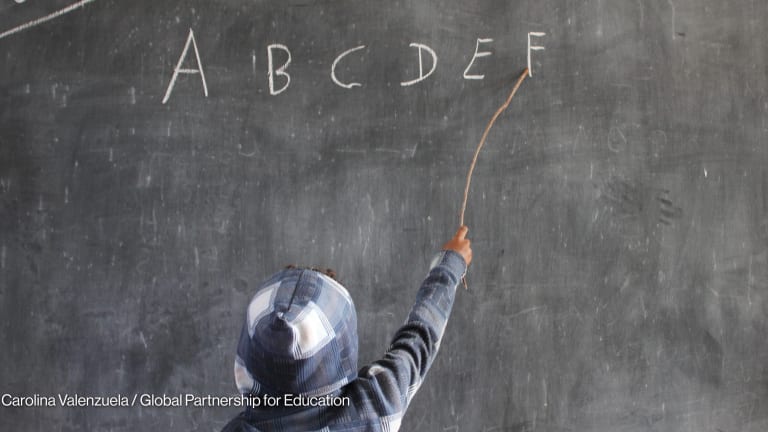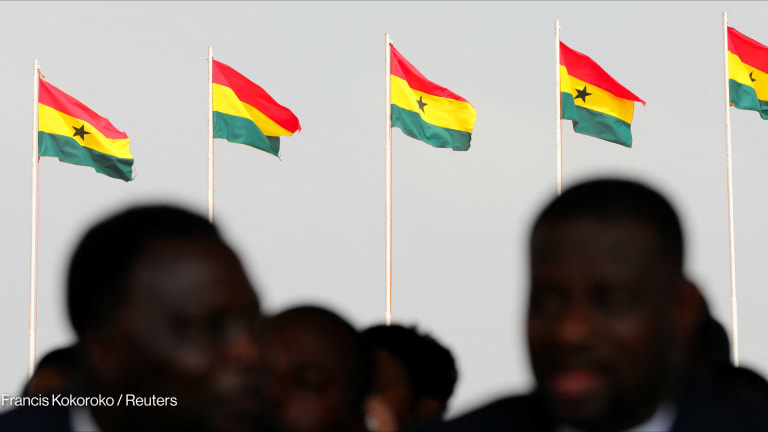
In 2015, world leaders committed to Sustainable Development Goal 4, which calls for the provision of inclusive and equitable quality education for all by 2030.
Despite that commitment, 263 million children and young people are still out of school, and after a decade of progress, the number of primary-aged children not in school is going up, not down. For those who are in school, many are not actually learning anything.
If current trends continue, only 1 out of 10 children in low-income countries will be on track to acquire basic secondary level skills by 2030.
— The Education CommissionIf current trends continue, only 1 out of 10 children in low-income countries will be on track to acquire basic secondary level skills by 2030. This is all a far cry from the ambition of SDG 4.
More funding to expand access and improve the quality of education is central to turning this around. The good news is that, after years of neglect, education financing is finally on the global agenda.
Education financing on the agenda and on the rise
After a period of stagnation, donor funding to education grew by 13 percent in 2016. But donors need to commit to do more and better. Aid budgets need to grow and more should be spent on education — up from 10 percent today to 15 percent by 2030. The majority of this must be directed to basic education in the poorest of countries.
More on GPE
► GPE to stay under World Bank but with more independence and 'new capabilities'
► GPE aims to improve transparency, monitoring of education funding pledges
► Julia Gillard on the future of the Global Partnership for Education
Last year at the Global Partnership for Education replenishment, we saw a growth in support for GPE. But given the need — together with the opportunity that GPE offers the international community to align funding to national priorities — it deserves more support.
The proposed International Finance Facility for Education, which aims to grow loan financing for education in lower-middle-income countries, is in the final design stages and is close to being agreed. It will play an important role in countries whose growing economies mean they aren’t eligible for existing loans or grants.
There has also been a growing recognition of the importance of education in emergencies. The European Union is leading the way and is on track to grow the proportion of humanitarian funding it dedicates to education from 1 percent in 2015 to 10 percent by the end of 2019. Other donors need to follow suit.
In 2016 we saw the creation of Education Cannot Wait, designed to ensure education for children affected by humanitarian crises. It aims to mobilize $1.8 billion in funding for education in emergencies by 2021.
GESF: What to watch at the 'Davos of education'
As 3,000 leaders and advocates head to Dubai this weekend for the Global Education & Skills Forum 2019, Devex rounds up the topics to watch.
Different agencies offer different comparative advantages. Each of these developments have an important and distinct role in closing the education financing gap, including by addressing problems that are specific to the issues and contexts for which they were established.
During my seven-year term on the GPE board — the last four as chair of the board’s Strategy & Policy Committee — I worked with colleagues on various reforms. This included the creation of a new mechanism designed to provide speedy support to countries affected by emergencies, or in need of funding to support early recovery.
I’m proud of that work, but it didn’t resolve the panoply of wider challenges for education in emergency situations, which Education Cannot Wait is now addressing.
Seeing Education Cannot Wait up close, including as a member of its executive committee, I’m more convinced than ever that a discrete organization with specific skills, experience, and operational capacity in emergencies is needed to address the persistent and unique challenges that education faces in humanitarian contexts.
Room for greater clarity and stronger alignment
More on education
► New principles on the right to public education released
► 'Teach' tool not for evaluating teachers, says World Bank education boss
But there’s still work to do in refining mandates, roles, and responsibilities. There is undoubtedly some confusion among donor and developing country governments and wider stakeholders about how both the existing and emerging education aid architecture works.
Donors have questions about what to support and what different organizations do and will deliver. Recipient countries have similar questions about the purpose of different sources of funding, and they face real challenges with the multiple transaction costs of dealing with different donors.
Taking inspiration from the health sector
We often compare the international education sector unfavorably to the health sector, which has more funding and more bodies administering it. But in 2018, at the suggestion of Germany, Ghana, and Norway, 12 global health organizations came together to develop the “Global Action Plan for healthy lives and well-being for all.”
Could schools take a cue from the health force?
Teachers across the globe are burdened with undue administrative workloads. That takes away valuable time for education, even as developing countries struggle to prepare their future workforce for a rapidly changing world. A 2018 pilot project is rethinking who, exactly, could support teachers.
Donor fatigue, concerns over proliferation, and the risk that disease specific approaches are undermining health systems strengthening contributed to the demand for a more united approach. The plan commits the 12 organizations to align and coordinate their work better, including by developing a common framework for assessing and reporting on results. It also identifies seven cross-cutting areas where more collaboration could accelerate progress.
An education equivalent would be an enormous boost, showing the world what’s possible when different funding mechanisms, operating with different mandates, and in different contexts come together to affirm shared goals and commit to work together to achieve them.
The case for a Global Education Funding Forum
Global education organizations are already doing this in practice. I’ve seen it first hand at inclusive board sessions in New York and at joint meetings in Kampala — but these efforts lack visibility and specificity. A practical way to give us both would be for the principals of the education aid architecture’s various agencies to create a Global Education Funding Forum.
The forum would allow education sector leaders to commit — like their counterparts in health — to aligning, accelerating, and accounting for their efforts in support of SDG 4. This would empower agency staff and partners to work together, especially when capacity constraints or the prospect of competition make it tough to do so. It would also grow the confidence of governments, both donor and developing, in the quality, efficiency, and growing effectiveness of aid to education.
The forum would help address concerns about fragmentation in the sector and continue to lay the groundwork for impactful collaboration, from resource mobilization to delivery.
By acting in this way the education sector would demonstrate its preparedness not just to create new ways of raising money, but also its commitment to use the money it receives wisely and in the service of a shared purpose.








